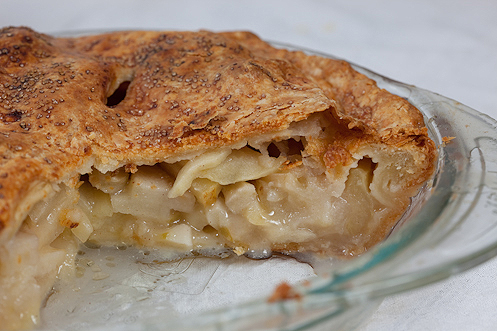5 weeks, 5 pies, 5 pounds
Andrea
When we moved to Virginia 4+ years ago, my momma told Brian and I about an incredible pie experience she’d had years prior at a little restaurant in Staunton, about 45 minutes from Charlottesville. She waxed poetic about an apple pie better than any she’d ever had, including her grandmother’s recipe which had previously held first place on her pie-ranking list. We were encouraged to drive over the mountain chain separating us from Mrs. Rowe’s Restaurant and Bakery one Saturday for a special treat, to indulge in one, or maybe even two slices of a pie that still had a mouth-watering affect on her all these years later.
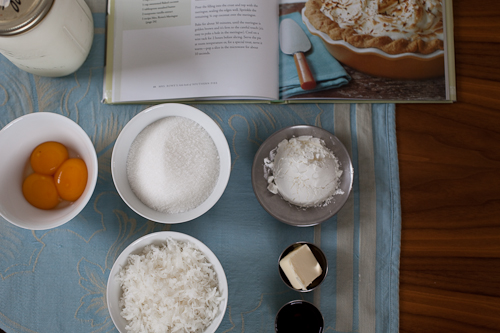 The restaurant and its legendary pie quickly slipped my mind as we moved into a house and started new jobs, busying ourselves with life in Charlottesville and the many culinary delights we have in this little city. I hadn’t thought of my momma’s story in 4 years, until I attended the C’ville Pie Fest and learned of Mollie Cox Bryan and the cookbook she’d written about Mrs. Rowe and her pies. I didn’t have the opportunity to meet Mollie as I was busy photographing and she was busy judging, but we did get in contact with each other afterwards via Twitter and she generously offered to send me a copy of her book to aid me in the kitchen during Bella Eats Pie Month.
The restaurant and its legendary pie quickly slipped my mind as we moved into a house and started new jobs, busying ourselves with life in Charlottesville and the many culinary delights we have in this little city. I hadn’t thought of my momma’s story in 4 years, until I attended the C’ville Pie Fest and learned of Mollie Cox Bryan and the cookbook she’d written about Mrs. Rowe and her pies. I didn’t have the opportunity to meet Mollie as I was busy photographing and she was busy judging, but we did get in contact with each other afterwards via Twitter and she generously offered to send me a copy of her book to aid me in the kitchen during Bella Eats Pie Month.
 The cookbook arrived on my doorstep a few days later, and I was delighted by what I found as I immediately began flipping through its pages. Mrs. Rowe’s Little Book of Southern Pies is lovely with a simple, intuitive layout and beautiful photos of many of the featured pies sprinkled throughout. Mollie starts by introducing her reader to Mildred Rowe and the Staunton restaurant, describing the space and the woman behind it with clarity and detail that only someone who has spent much time there could. The reader is then taken through one section detailing pie-making equipment and another describing techniques for various crusts and toppings. While the Plain Pie Pastry and Vinegar Pie Crust recipes seem simple enough, Mollie points out that the light touch of an experienced baker can take years to master. I plan to continue practicing.
The cookbook arrived on my doorstep a few days later, and I was delighted by what I found as I immediately began flipping through its pages. Mrs. Rowe’s Little Book of Southern Pies is lovely with a simple, intuitive layout and beautiful photos of many of the featured pies sprinkled throughout. Mollie starts by introducing her reader to Mildred Rowe and the Staunton restaurant, describing the space and the woman behind it with clarity and detail that only someone who has spent much time there could. The reader is then taken through one section detailing pie-making equipment and another describing techniques for various crusts and toppings. While the Plain Pie Pastry and Vinegar Pie Crust recipes seem simple enough, Mollie points out that the light touch of an experienced baker can take years to master. I plan to continue practicing.
 Despite its petite size, Mrs. Rowe’s Little Book of Southern Pies is packed with useful tips and 65 recipes, some straight from Mrs. Rowe’s Restaurant and Bakery and others from journals found during Mollie’s research. Restaurant favorites such as the Original Coconut Cream Pie, Chocolate Meringue Pie, Peanut Butter Pie and French Apple Pie are all present along with some classic Southern varieties like Shoofly Pie, Lemon Chess Pie and Blackberry Pie. Each recipe is accompanied by a small tidbit of history, a direct quote from a member of the Mrs. Rowe's team or a memory from a loyal customer. The book is personal; peppered with heartfelt writing and recipes that are sure to remind you of a special occasion in your life, when a certain pie was served to a table full of your closest family or friends.
Despite its petite size, Mrs. Rowe’s Little Book of Southern Pies is packed with useful tips and 65 recipes, some straight from Mrs. Rowe’s Restaurant and Bakery and others from journals found during Mollie’s research. Restaurant favorites such as the Original Coconut Cream Pie, Chocolate Meringue Pie, Peanut Butter Pie and French Apple Pie are all present along with some classic Southern varieties like Shoofly Pie, Lemon Chess Pie and Blackberry Pie. Each recipe is accompanied by a small tidbit of history, a direct quote from a member of the Mrs. Rowe's team or a memory from a loyal customer. The book is personal; peppered with heartfelt writing and recipes that are sure to remind you of a special occasion in your life, when a certain pie was served to a table full of your closest family or friends.
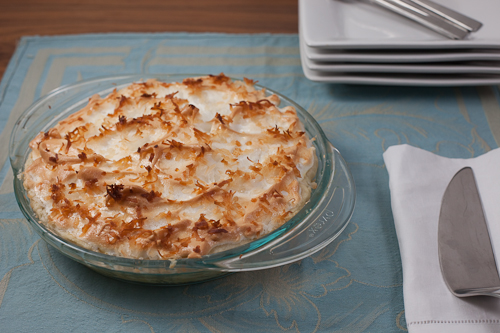 I chose to tackle the Original Coconut Cream Pie recipe rather than the apple variety my momma had raved about. As the best-selling pie at Mrs. Rowe's Restaurant and Bakery it seemed to be a safe bet. And, I really wanted to try my hand at meringue, a baking challenge I hadn’t yet subjected myself to.
I found the recipe to be fairly easy to follow, although previous experience baking cream pies might have been helpful to me. Where the recipe called for a mixture of milk, sugar, cornstarch and egg yolks to be heated and stirred until "very thick", about 4 minutes, I had no frame of reference in mind for what that consistency should be. Having reached 6 minutes with a pudding-like consistency, I pulled the mixture from the heat thinking it would thicken up more when baked. No such luck. Upon slicing, the cream filling oozed from the center of the slice into a pool on the plate. Clearly my idea of "very thick" was not thick enough. The meringue, however, was absolutely perfect.
I chose to tackle the Original Coconut Cream Pie recipe rather than the apple variety my momma had raved about. As the best-selling pie at Mrs. Rowe's Restaurant and Bakery it seemed to be a safe bet. And, I really wanted to try my hand at meringue, a baking challenge I hadn’t yet subjected myself to.
I found the recipe to be fairly easy to follow, although previous experience baking cream pies might have been helpful to me. Where the recipe called for a mixture of milk, sugar, cornstarch and egg yolks to be heated and stirred until "very thick", about 4 minutes, I had no frame of reference in mind for what that consistency should be. Having reached 6 minutes with a pudding-like consistency, I pulled the mixture from the heat thinking it would thicken up more when baked. No such luck. Upon slicing, the cream filling oozed from the center of the slice into a pool on the plate. Clearly my idea of "very thick" was not thick enough. The meringue, however, was absolutely perfect.
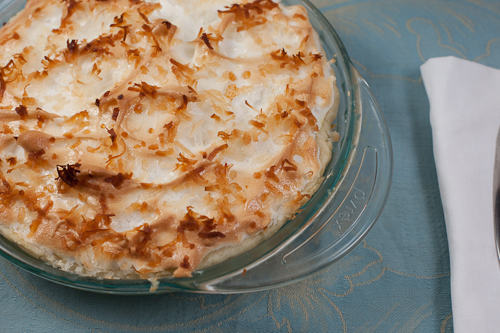
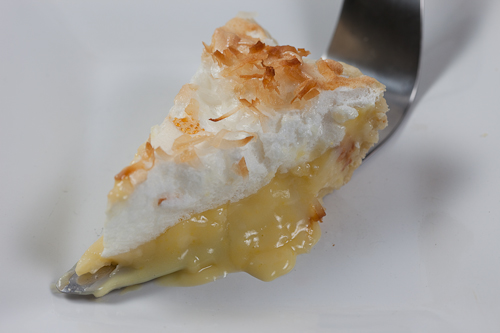
 And that concludes Bella Eats Pie Month! 5 weeks, 5 varieties, and 5 pounds later, I've learned so much and hope you have too. Please write and tell me about any of these or other pie recipes that you try out this holiday season. I'd love to hear from you.
While I'm ready to take a short break from pie, as are all of our friends and co-workers, I look forward to continuing my experimentation and sharing more pie recipes with you in the future. Here are a few more on my list to try:
Peanut Butter Banana Cream Pie
Key Lime Pie
Bourbon Peach Hand Pies
Lemon Meringue Pie
Pear Cranberry Pie
And that concludes Bella Eats Pie Month! 5 weeks, 5 varieties, and 5 pounds later, I've learned so much and hope you have too. Please write and tell me about any of these or other pie recipes that you try out this holiday season. I'd love to hear from you.
While I'm ready to take a short break from pie, as are all of our friends and co-workers, I look forward to continuing my experimentation and sharing more pie recipes with you in the future. Here are a few more on my list to try:
Peanut Butter Banana Cream Pie
Key Lime Pie
Bourbon Peach Hand Pies
Lemon Meringue Pie
Pear Cranberry Pie
Read More
 The restaurant and its legendary pie quickly slipped my mind as we moved into a house and started new jobs, busying ourselves with life in Charlottesville and the many culinary delights we have in this little city. I hadn’t thought of my momma’s story in 4 years, until I attended the C’ville Pie Fest and learned of Mollie Cox Bryan and the cookbook she’d written about Mrs. Rowe and her pies. I didn’t have the opportunity to meet Mollie as I was busy photographing and she was busy judging, but we did get in contact with each other afterwards via Twitter and she generously offered to send me a copy of her book to aid me in the kitchen during Bella Eats Pie Month.
The restaurant and its legendary pie quickly slipped my mind as we moved into a house and started new jobs, busying ourselves with life in Charlottesville and the many culinary delights we have in this little city. I hadn’t thought of my momma’s story in 4 years, until I attended the C’ville Pie Fest and learned of Mollie Cox Bryan and the cookbook she’d written about Mrs. Rowe and her pies. I didn’t have the opportunity to meet Mollie as I was busy photographing and she was busy judging, but we did get in contact with each other afterwards via Twitter and she generously offered to send me a copy of her book to aid me in the kitchen during Bella Eats Pie Month.
 The cookbook arrived on my doorstep a few days later, and I was delighted by what I found as I immediately began flipping through its pages. Mrs. Rowe’s Little Book of Southern Pies is lovely with a simple, intuitive layout and beautiful photos of many of the featured pies sprinkled throughout. Mollie starts by introducing her reader to Mildred Rowe and the Staunton restaurant, describing the space and the woman behind it with clarity and detail that only someone who has spent much time there could. The reader is then taken through one section detailing pie-making equipment and another describing techniques for various crusts and toppings. While the Plain Pie Pastry and Vinegar Pie Crust recipes seem simple enough, Mollie points out that the light touch of an experienced baker can take years to master. I plan to continue practicing.
The cookbook arrived on my doorstep a few days later, and I was delighted by what I found as I immediately began flipping through its pages. Mrs. Rowe’s Little Book of Southern Pies is lovely with a simple, intuitive layout and beautiful photos of many of the featured pies sprinkled throughout. Mollie starts by introducing her reader to Mildred Rowe and the Staunton restaurant, describing the space and the woman behind it with clarity and detail that only someone who has spent much time there could. The reader is then taken through one section detailing pie-making equipment and another describing techniques for various crusts and toppings. While the Plain Pie Pastry and Vinegar Pie Crust recipes seem simple enough, Mollie points out that the light touch of an experienced baker can take years to master. I plan to continue practicing.
 Despite its petite size, Mrs. Rowe’s Little Book of Southern Pies is packed with useful tips and 65 recipes, some straight from Mrs. Rowe’s Restaurant and Bakery and others from journals found during Mollie’s research. Restaurant favorites such as the Original Coconut Cream Pie, Chocolate Meringue Pie, Peanut Butter Pie and French Apple Pie are all present along with some classic Southern varieties like Shoofly Pie, Lemon Chess Pie and Blackberry Pie. Each recipe is accompanied by a small tidbit of history, a direct quote from a member of the Mrs. Rowe's team or a memory from a loyal customer. The book is personal; peppered with heartfelt writing and recipes that are sure to remind you of a special occasion in your life, when a certain pie was served to a table full of your closest family or friends.
Despite its petite size, Mrs. Rowe’s Little Book of Southern Pies is packed with useful tips and 65 recipes, some straight from Mrs. Rowe’s Restaurant and Bakery and others from journals found during Mollie’s research. Restaurant favorites such as the Original Coconut Cream Pie, Chocolate Meringue Pie, Peanut Butter Pie and French Apple Pie are all present along with some classic Southern varieties like Shoofly Pie, Lemon Chess Pie and Blackberry Pie. Each recipe is accompanied by a small tidbit of history, a direct quote from a member of the Mrs. Rowe's team or a memory from a loyal customer. The book is personal; peppered with heartfelt writing and recipes that are sure to remind you of a special occasion in your life, when a certain pie was served to a table full of your closest family or friends.
 I chose to tackle the Original Coconut Cream Pie recipe rather than the apple variety my momma had raved about. As the best-selling pie at Mrs. Rowe's Restaurant and Bakery it seemed to be a safe bet. And, I really wanted to try my hand at meringue, a baking challenge I hadn’t yet subjected myself to.
I found the recipe to be fairly easy to follow, although previous experience baking cream pies might have been helpful to me. Where the recipe called for a mixture of milk, sugar, cornstarch and egg yolks to be heated and stirred until "very thick", about 4 minutes, I had no frame of reference in mind for what that consistency should be. Having reached 6 minutes with a pudding-like consistency, I pulled the mixture from the heat thinking it would thicken up more when baked. No such luck. Upon slicing, the cream filling oozed from the center of the slice into a pool on the plate. Clearly my idea of "very thick" was not thick enough. The meringue, however, was absolutely perfect.
I chose to tackle the Original Coconut Cream Pie recipe rather than the apple variety my momma had raved about. As the best-selling pie at Mrs. Rowe's Restaurant and Bakery it seemed to be a safe bet. And, I really wanted to try my hand at meringue, a baking challenge I hadn’t yet subjected myself to.
I found the recipe to be fairly easy to follow, although previous experience baking cream pies might have been helpful to me. Where the recipe called for a mixture of milk, sugar, cornstarch and egg yolks to be heated and stirred until "very thick", about 4 minutes, I had no frame of reference in mind for what that consistency should be. Having reached 6 minutes with a pudding-like consistency, I pulled the mixture from the heat thinking it would thicken up more when baked. No such luck. Upon slicing, the cream filling oozed from the center of the slice into a pool on the plate. Clearly my idea of "very thick" was not thick enough. The meringue, however, was absolutely perfect.

Some Notes on Cream Pies and Meringue Tops
The runny nature of my pie was most certainly the result of my own lack of experience in cream pie baking and not the fault of the recipe itself. Here are my notes for the next time I tackle a cream pie.Many cream pie recipes call for the use of a double boiler when heating and thickening the cream mixture. A double boiler is basically two saucepans that fit together, allowing water to boil in the larger pan with your cream mixture heated in the smaller pan set just above the boiling water. I realized after this latest pie-making adventure that my "double boiler" is not really a double boiler in the traditional sense. I think it hindered my process rather than helped it, and believe I would have been better off setting a large stainless steel bowl containing my cream mixture over a large saucepan containing boiling water. If you're shopping for a double boiler, find one that looks like this, rather than like this. Or, just set a stainless steel bowl over a saucepan. When heating and thickening the cream mixture, the texture is more important than the time it takes to get to that texture. As I learned, all stove tops and double boilers are different, so it could take more or less time to reach the desired consistency depending on your situation. You're going for a thick, custard-like consistency. It shouldn't be runny at all, should fall from a spoon with a thick "plop" rather than run off of the spoon with any resemblance to liquid. Don't let the milk actually come to a boil as you're heating it, you don't want it to scald. Your meringue will take more or less time to come together depending on your environment. Mine took about 10 minutes of consistent beating with a stand mixer (whisk attachment), on a cool, rainy day. When making your meringue be sure to add your sugar slowly, as it is important for all of the sugar to dissolve into the egg whites between each addition. Meringues are subject to "weeping", when the sugar solution comes out of the meringue in little droplets. This happened with mine, and after a little research in The Joy of Cooking I discovered that it is more likely for a meringue to weep on a humid day. It still tasted delicious, there were just small droplets of liquid sugar sprinkled across the surface of the meringue, and it wasn't as dry to the touch as you would expect it to be. Be sure not to overfill your pie crust with your cream filling. Leave at least 1/4-inch of the crust exposed to be sure your filling doesn't overflow. Also, when you add your meringue to the top of the filling it can cause overflow, so it is good to have a little bit of wiggle room as you design your topping. Meringue can be shaped with a spatula in any way you wish. Smooth it over, swirl it around, form fancy little peaks. Let your inner artist shine! Seal the edges of your meringue by wetting your finger with cold water and running it over the rim of your crust. Press the meringue down into your crust to help prevent weeping and potential filling overflow.

Original Coconut Cream Pie
from Mrs. Rowe's Little Book of Southern Pies by Mollie Cox Bryan, pg 64 I've written the recipe as it appears in the cookbook, but see my notes above to learn from my mistakes. makes one 9-inch pie Ingredients:- 1/2 recipe plain or vinegar pie crust (I used this one because I had it in my freezer already), prebaked
- 3 large egg yolks (be sure to reserve the whites for the meringue, below)
- 1 cup sugar
- 1/4 cup cornstarch
- 1/4 to 1/2 cup water
- 3 cups whole milk
- 1 cup sweetened flaked coconut
- 1 tbsp unsalted butter
- 2 tsp vanilla extract
- 1 recipe Mrs. Rowe's Meringue (below)
- Preheat the oven to 325*.
- Stir together the egg yolks, sugar, cornstarch and just enough of the water to make a smooth paste.
- Heat the milk in a double boiler set over simmering water. (Or, place a medium-size stainless steel or glass bowl into a large saucepan filled with a couple of inches of simmering water.) When the milk begins to steam gradually whisk in the egg mixture. Cook, stirring occasionally, until very thick, about 4 minutes. Remove from the heat and stir in 3/4 cup of the coconut, the butter and the vanilla. Set aside.
- Make your meringue, see below.
- Pour the filling into the prebaked crust and top with the meringue. Seal the edges well by wetting your finger with cold water and running it along the edge of the crust, pressing the meringue into the crust as you go. Sprinkle the remaining 1/4 cup coconut over the meringue.
- Bake for about 30 minutes, until the meringue is golden brown and its firm to the careful touch (its easy to poke a hole in the meringue). Cool on a wire rack for at least 2 hours before slicing.
Mrs. Rowe's Meringue
makes enough to cover one 9-inch pie Ingredients:- 4 large egg whites, at room temperature
- 1/4 tsp cream of tartar
- 3 tbsp granulated sugar
- Combine the egg whites and cream of tartar in a chilled bowl and beat with an electric mixer on slow speed. Gradually increase the speed as the egg whites thicken, eventually landing on medium speed. Beat until soft peaks form. Add the sugar 1 tbsp at a time, beating for about a minute after each addition. Beat until stiff peaks form, but not so long that the peaks become dry. The meringue is now ready to pile lightly over the pie.
 And that concludes Bella Eats Pie Month! 5 weeks, 5 varieties, and 5 pounds later, I've learned so much and hope you have too. Please write and tell me about any of these or other pie recipes that you try out this holiday season. I'd love to hear from you.
While I'm ready to take a short break from pie, as are all of our friends and co-workers, I look forward to continuing my experimentation and sharing more pie recipes with you in the future. Here are a few more on my list to try:
Peanut Butter Banana Cream Pie
Key Lime Pie
Bourbon Peach Hand Pies
Lemon Meringue Pie
Pear Cranberry Pie
And that concludes Bella Eats Pie Month! 5 weeks, 5 varieties, and 5 pounds later, I've learned so much and hope you have too. Please write and tell me about any of these or other pie recipes that you try out this holiday season. I'd love to hear from you.
While I'm ready to take a short break from pie, as are all of our friends and co-workers, I look forward to continuing my experimentation and sharing more pie recipes with you in the future. Here are a few more on my list to try:
Peanut Butter Banana Cream Pie
Key Lime Pie
Bourbon Peach Hand Pies
Lemon Meringue Pie
Pear Cranberry Pie As I flew over Charlottesville last Thursday en route to Florida I took note of the fiery colors starting to present themselves in the trees below. The deep orange and bright yellow hues stood out in the dark green forest like fireworks in a midnight sky. Autumnal thoughts quickly left my mind as I jetted towards a weekend to be spent with family and friends in weather that required sundresses and sandals rather than corduroy pants and scarves. Outdoor dining options were declined in favor of cool indoor air conditioning as we all sipped punch made from honeydew, mint and ginger ale. The summertime frame of mind embedded itself so deeply in my subconscious that I boarded the flight home on Sunday in a tank top and flip flops, not thinking about the sub-50-degree air I would be greeted with as I deplaned at CHO.
As I flew over Charlottesville last Thursday en route to Florida I took note of the fiery colors starting to present themselves in the trees below. The deep orange and bright yellow hues stood out in the dark green forest like fireworks in a midnight sky. Autumnal thoughts quickly left my mind as I jetted towards a weekend to be spent with family and friends in weather that required sundresses and sandals rather than corduroy pants and scarves. Outdoor dining options were declined in favor of cool indoor air conditioning as we all sipped punch made from honeydew, mint and ginger ale. The summertime frame of mind embedded itself so deeply in my subconscious that I boarded the flight home on Sunday in a tank top and flip flops, not thinking about the sub-50-degree air I would be greeted with as I deplaned at CHO.
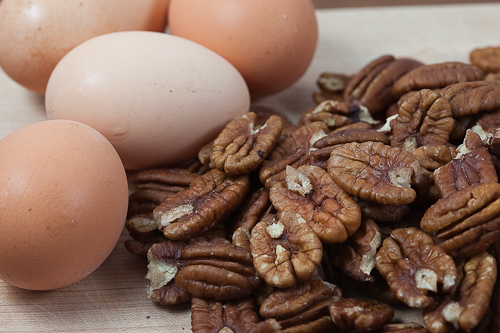 Despite the 85-degree weather and ever-present green of my home state, during my visit last weekend there were a couple of clues that indicated the current season. The stores there all have the same picked-over Halloween costume aisles and sections devoted to Thanksgiving decorations as we have in Virginia. Restaurant menus show some seasonal specials featuring sweet potatoes and cranberries, and the slight drop in nighttime temperature has Floridians pulling out their lightweight fleece hoodies to protect themselves from the “cold”. The light has changed, lower and more golden that it was when I last visited a few months ago. But the indicator that hit home most with me, that brought back a flood of childhood memories of Autumn in Florida, was the giant box of full-size candy bars I noticed stashed close to the front door at my daddy’s house.
Despite the 85-degree weather and ever-present green of my home state, during my visit last weekend there were a couple of clues that indicated the current season. The stores there all have the same picked-over Halloween costume aisles and sections devoted to Thanksgiving decorations as we have in Virginia. Restaurant menus show some seasonal specials featuring sweet potatoes and cranberries, and the slight drop in nighttime temperature has Floridians pulling out their lightweight fleece hoodies to protect themselves from the “cold”. The light has changed, lower and more golden that it was when I last visited a few months ago. But the indicator that hit home most with me, that brought back a flood of childhood memories of Autumn in Florida, was the giant box of full-size candy bars I noticed stashed close to the front door at my daddy’s house.
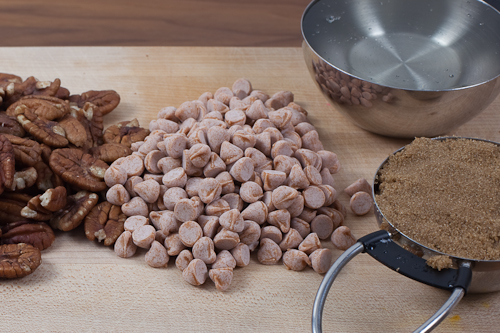 Growing up in Florida, Autumn had a very different feel than it does now that I live in Virginia. In my life now, Autumn means festivals and apple picking, changing leaves and layered clothing. We attend sheepdog trials and buy pumpkins from local farmers, plan parties with locally made hard cider and hand-dipped caramel apples. In Florida, in my youth, I remember the night air turning a little bit cooler and being very, very excited if I spotted a tree changing from green to a pale yellow-brown as I drove past on the interstate. I'd insist on wearing a sweater for Thanksgiving dinner no matter the temperature outside and the fact that I may sweat through it, and longed for a day when I could justify the purchase of a scarf. And then, of course, there was Halloween. For me, Autumn in Florida was all about Halloween.
Growing up in Florida, Autumn had a very different feel than it does now that I live in Virginia. In my life now, Autumn means festivals and apple picking, changing leaves and layered clothing. We attend sheepdog trials and buy pumpkins from local farmers, plan parties with locally made hard cider and hand-dipped caramel apples. In Florida, in my youth, I remember the night air turning a little bit cooler and being very, very excited if I spotted a tree changing from green to a pale yellow-brown as I drove past on the interstate. I'd insist on wearing a sweater for Thanksgiving dinner no matter the temperature outside and the fact that I may sweat through it, and longed for a day when I could justify the purchase of a scarf. And then, of course, there was Halloween. For me, Autumn in Florida was all about Halloween.
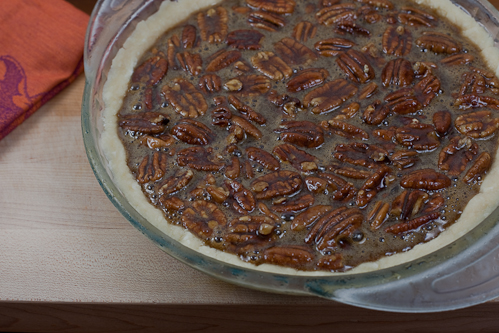 The party planning started in September. Each year my parents and I (well, my parents, really) hosted a huge Halloween bash at our house, complete with haunted cemetery in the yard, costume contest, bobbing for apples or, when my friends and I all had braces, eating donuts hung from the rafters of our back porch with hands tied behind our backs. Evenings and weekends prior to the big day were spent with my father in the garage, drawing tombstone shapes on giant pieces of foam and cutting them out with a hot knife, the smell of melting styrofoam permeating the space for weeks. Daddy is a perfectionist, so the paint job those tombstones and the corresponding cemetery sign that arched high over the gate to our back yard received was perfect. That was one scary cemetery my friends had to walk through to get to the fun and games.
The party planning started in September. Each year my parents and I (well, my parents, really) hosted a huge Halloween bash at our house, complete with haunted cemetery in the yard, costume contest, bobbing for apples or, when my friends and I all had braces, eating donuts hung from the rafters of our back porch with hands tied behind our backs. Evenings and weekends prior to the big day were spent with my father in the garage, drawing tombstone shapes on giant pieces of foam and cutting them out with a hot knife, the smell of melting styrofoam permeating the space for weeks. Daddy is a perfectionist, so the paint job those tombstones and the corresponding cemetery sign that arched high over the gate to our back yard received was perfect. That was one scary cemetery my friends had to walk through to get to the fun and games.
 Come Halloween night, a few days after our party, my father gave, and still gives, full-size candy bars out to trick-or-treaters. Full-size. All of the neighborhood kids know about my dad and the top-notch treats he gives out, which means he buys a lot of candy bars. I enjoyed trick-or-treating as a child, but what I enjoyed even more as a young adult was staying home with Daddy, handing out those candy bars to the costumed youth and hearing the excited tone of their voices as they whispered to each other "see! I told you he gave out the good stuff!" I'd look over at Daddy, who would grin and chuckle and comment on all of their costumes as he dropped bars into their buckets, and smile with pride that I had the cool dad who gave out the good stuff.
Come Halloween night, a few days after our party, my father gave, and still gives, full-size candy bars out to trick-or-treaters. Full-size. All of the neighborhood kids know about my dad and the top-notch treats he gives out, which means he buys a lot of candy bars. I enjoyed trick-or-treating as a child, but what I enjoyed even more as a young adult was staying home with Daddy, handing out those candy bars to the costumed youth and hearing the excited tone of their voices as they whispered to each other "see! I told you he gave out the good stuff!" I'd look over at Daddy, who would grin and chuckle and comment on all of their costumes as he dropped bars into their buckets, and smile with pride that I had the cool dad who gave out the good stuff.
 That's my daddy, generous to a fault, always giving out the good stuff. Whether it be full-size candy bars to strangers on Halloween, time on the telephone working through digital camera and photography questions or unbelievably kind gifts, he's always striving to put a smile on the faces of those surrounding him. At this time of year, especially, I am nostalgic for my youth and the time I spent with him each fall, wishing I could fold his tradition of handing out full-size candy bars into my life now and regretting that we live in a neighborhood that trick-or-treaters don't visit. So instead, I made Daddy's favorite kind of pie and thought ahead to Thanksgiving, when we'll sit around the same table with Brian and all of my stepfamily and enjoy an Autumn meal together.
That's my daddy, generous to a fault, always giving out the good stuff. Whether it be full-size candy bars to strangers on Halloween, time on the telephone working through digital camera and photography questions or unbelievably kind gifts, he's always striving to put a smile on the faces of those surrounding him. At this time of year, especially, I am nostalgic for my youth and the time I spent with him each fall, wishing I could fold his tradition of handing out full-size candy bars into my life now and regretting that we live in a neighborhood that trick-or-treaters don't visit. So instead, I made Daddy's favorite kind of pie and thought ahead to Thanksgiving, when we'll sit around the same table with Brian and all of my stepfamily and enjoy an Autumn meal together.
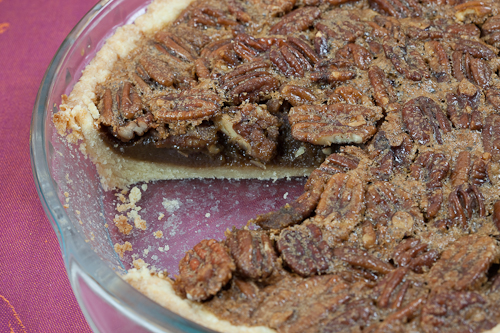 I tried out two different pecan pie recipes this week along with two different crusts. The first is more of an old-fashioned pecan pie, the filling made with dark brown sugar, butter, egg and a splash of bourbon with the pecan halves kept intact. The second pie filling consisted of a little bit of dark brown sugar paired with a lot more corn syrup, butterscotch chips, eggs and chopped pecans. They were both delicious, although there was a definite favorite amongst those surveyed at my office and in our home. I am hesitant to tell you which it was, as both recipes are great and I really recommend that you choose your favorite based on your own tastes.
I tried out two different pecan pie recipes this week along with two different crusts. The first is more of an old-fashioned pecan pie, the filling made with dark brown sugar, butter, egg and a splash of bourbon with the pecan halves kept intact. The second pie filling consisted of a little bit of dark brown sugar paired with a lot more corn syrup, butterscotch chips, eggs and chopped pecans. They were both delicious, although there was a definite favorite amongst those surveyed at my office and in our home. I am hesitant to tell you which it was, as both recipes are great and I really recommend that you choose your favorite based on your own tastes.
 Devoid of corn syrup, this pie has the dense texture that I associate with the old-fashioned pecan pie. It is sweet, being mostly sugar, but the bourbon adds a nice mild kick to the bite and a pleasant aftertaste that cuts the sweetness quite successfully.
Devoid of corn syrup, this pie has the dense texture that I associate with the old-fashioned pecan pie. It is sweet, being mostly sugar, but the bourbon adds a nice mild kick to the bite and a pleasant aftertaste that cuts the sweetness quite successfully.
 With corn syrup used as the main sweetener and the addition of butterscotch chips, this pie is ultra-sweet. The filling is silkier than the pie above, and the chopped pecans make each bite more consistent in texture. I loved the addition of butterscotch in this pie, and know my daddy will too as he is a big fan of those little golden chips.
With corn syrup used as the main sweetener and the addition of butterscotch chips, this pie is ultra-sweet. The filling is silkier than the pie above, and the chopped pecans make each bite more consistent in texture. I loved the addition of butterscotch in this pie, and know my daddy will too as he is a big fan of those little golden chips.
 Joy is right - this pie crust is easy! If you're wanting to make a crust without much notice, or are intimidated by crusts that require rolling, this recipe is for you. The final texture was more crumbly than flakey and reminded me of the consistency of a shortbread cookie. But it held together nicely when sliced and has a pleasant, mild flavor.
Joy is right - this pie crust is easy! If you're wanting to make a crust without much notice, or are intimidated by crusts that require rolling, this recipe is for you. The final texture was more crumbly than flakey and reminded me of the consistency of a shortbread cookie. But it held together nicely when sliced and has a pleasant, mild flavor.
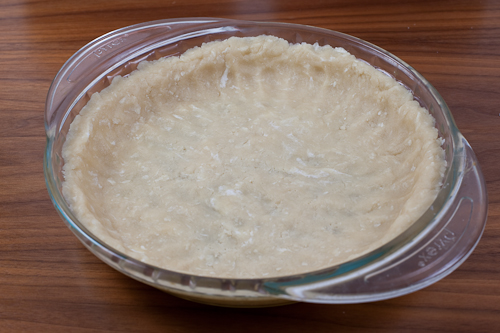 Ok, so this crust IS pretty perfect. It is an all-shortening crust, which I've never made before, and I was incredibly impressed with the flakey result. The flavor was delicious (although not as good as all butter, in my opinion) and the texture couldn't be beat . One warning, it shrinks with baking, as shortening literally "shortens" the gluten strands in the dough even more so than butter. Before pre-baking, the crust pictured below reached the top of my pie pan. So, be sure not to fill the crust as much as you normally would if you don't pre-bake.
Ok, so this crust IS pretty perfect. It is an all-shortening crust, which I've never made before, and I was incredibly impressed with the flakey result. The flavor was delicious (although not as good as all butter, in my opinion) and the texture couldn't be beat . One warning, it shrinks with baking, as shortening literally "shortens" the gluten strands in the dough even more so than butter. Before pre-baking, the crust pictured below reached the top of my pie pan. So, be sure not to fill the crust as much as you normally would if you don't pre-bake.
 I've decided to extend Bella Eats Pie Month into November for one more week, so be sure to visit next Thursday for the last installment, Coconut Cream Pie, along with a review of
I've decided to extend Bella Eats Pie Month into November for one more week, so be sure to visit next Thursday for the last installment, Coconut Cream Pie, along with a review of  Our car winds its way up the narrow gravel road to the top of
Our car winds its way up the narrow gravel road to the top of  Once parked we make our way through the crowd towards the renovated barn, dodging bundled-up children being pulled in bright red Radio Flyer wagons by slightly-frazzled parents. The smell of freshly baked apple pie and apple cider doughnuts fills the air as we find the ‘pick-your-own’ information kiosk, grab a bag, ask about availability and set off on our hunt for sweet and crisp Fuji apples. We continue our journey towards the top of the mountain, this time on foot, huffing and puffing just a little as I am reminded again of why I should wear sturdier shoes on these treks. Fifteen minutes later we have found rows full of our target. The bright pink globes dance in the wind and beg to be picked, and I am thankful again that Brian is tall and can reach the otherwise unattainable perfect specimens near the tops of the trees.
Once parked we make our way through the crowd towards the renovated barn, dodging bundled-up children being pulled in bright red Radio Flyer wagons by slightly-frazzled parents. The smell of freshly baked apple pie and apple cider doughnuts fills the air as we find the ‘pick-your-own’ information kiosk, grab a bag, ask about availability and set off on our hunt for sweet and crisp Fuji apples. We continue our journey towards the top of the mountain, this time on foot, huffing and puffing just a little as I am reminded again of why I should wear sturdier shoes on these treks. Fifteen minutes later we have found rows full of our target. The bright pink globes dance in the wind and beg to be picked, and I am thankful again that Brian is tall and can reach the otherwise unattainable perfect specimens near the tops of the trees.
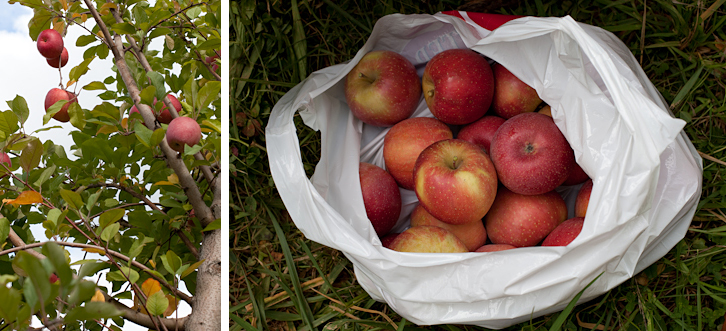 We fill our first bag, saving the second for a bin full of bright green Granny Smiths calling our name back at the barn. The pick-your-own trees once dripping with that variety were stripped the previous two weekends during the
We fill our first bag, saving the second for a bin full of bright green Granny Smiths calling our name back at the barn. The pick-your-own trees once dripping with that variety were stripped the previous two weekends during the  I knew from the first moment that Brian and I started talking about
I knew from the first moment that Brian and I started talking about  I really wanted to try something new (to us, at least) for Pie Month, and so started to look into apple pie variations. Initially Brian balked, for even though he is a fan of the apple cranberry pie I make every year, he is truly a classicist when it comes to his favorite dishes and was not keen on the idea of my shaking things up. Until a reader, Hannah, was sweet enough to send me her grandmother’s recipe for Cheddar Apple Pie. Cheddar? Apples? Yum! I’m embarrassed to say that we’d never even heard of such a pie in our household, not even the Wisconsin tradition of layering a slice of cheddar across a warm slice of freshly-baked apple pie. The idea appealed to both of us, especially Brian’s not-so-sweet tooth, and so Cheddar Apple Pie was penciled into the agenda.
I really wanted to try something new (to us, at least) for Pie Month, and so started to look into apple pie variations. Initially Brian balked, for even though he is a fan of the apple cranberry pie I make every year, he is truly a classicist when it comes to his favorite dishes and was not keen on the idea of my shaking things up. Until a reader, Hannah, was sweet enough to send me her grandmother’s recipe for Cheddar Apple Pie. Cheddar? Apples? Yum! I’m embarrassed to say that we’d never even heard of such a pie in our household, not even the Wisconsin tradition of layering a slice of cheddar across a warm slice of freshly-baked apple pie. The idea appealed to both of us, especially Brian’s not-so-sweet tooth, and so Cheddar Apple Pie was penciled into the agenda.
 A bit more research later, and I discovered that I’d overlooked the
A bit more research later, and I discovered that I’d overlooked the  As with most recipes I've tried from within the pages of Gourmet, this one came together beautifully. Once the dough softened up a bit and stopped giving me a killer upper-body workout, it was a dream to work with. No tears or splits or crumbles except for at the edges. The slight sweetness of the filling was perfectly balanced by the savory tone of the crust, which flaked just as it was meant to and melted away on the tongue. The cheddar added a nice punch that left me wishing I had baked off the scraps leftover after trimming the pie's edge, imagining that pairing those crispy strips with slices of fresh apple would have provided a perfect afternoon snack.
The not-too-sweet nature of this pie was the perfect follow-up to the rich chocolate + caramel pies I was producing last week. If you have loved ones who aren't big dessert fans, who just don't have much of a sweet tooth, this pie is the answer to your "what shall I make" questions. Even Brian, who has been known to pass up cake / cookies / pie / ice cream in favor of an extra helping of meat or mashed potatoes, consumed multiple pieces of this pie in a day. And then did it again the next. This pie is a winner, indeed.
As with most recipes I've tried from within the pages of Gourmet, this one came together beautifully. Once the dough softened up a bit and stopped giving me a killer upper-body workout, it was a dream to work with. No tears or splits or crumbles except for at the edges. The slight sweetness of the filling was perfectly balanced by the savory tone of the crust, which flaked just as it was meant to and melted away on the tongue. The cheddar added a nice punch that left me wishing I had baked off the scraps leftover after trimming the pie's edge, imagining that pairing those crispy strips with slices of fresh apple would have provided a perfect afternoon snack.
The not-too-sweet nature of this pie was the perfect follow-up to the rich chocolate + caramel pies I was producing last week. If you have loved ones who aren't big dessert fans, who just don't have much of a sweet tooth, this pie is the answer to your "what shall I make" questions. Even Brian, who has been known to pass up cake / cookies / pie / ice cream in favor of an extra helping of meat or mashed potatoes, consumed multiple pieces of this pie in a day. And then did it again the next. This pie is a winner, indeed.
 I had an additional apple pie planned for the week, a
I had an additional apple pie planned for the week, a  Cheddar-Crusted Apple Pie
Cheddar-Crusted Apple Pie
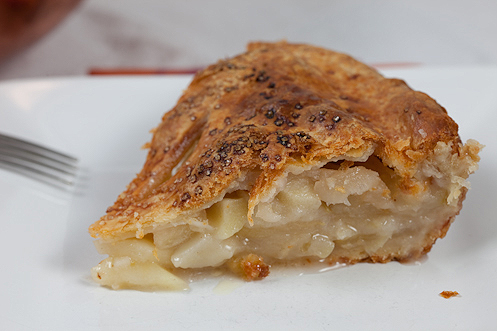 Notes:
Notes:
